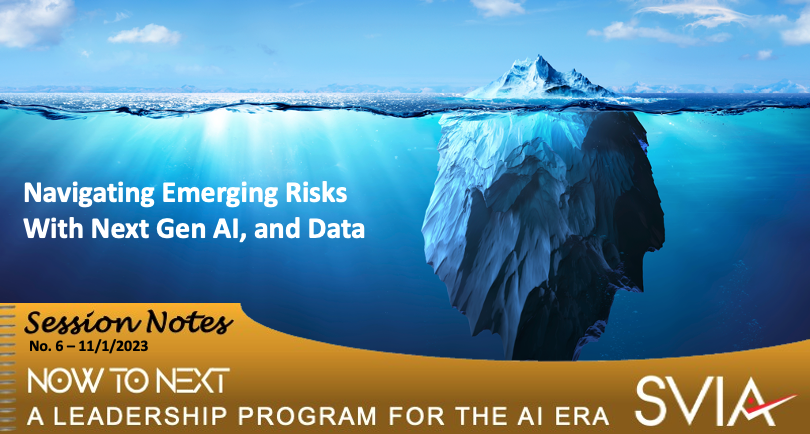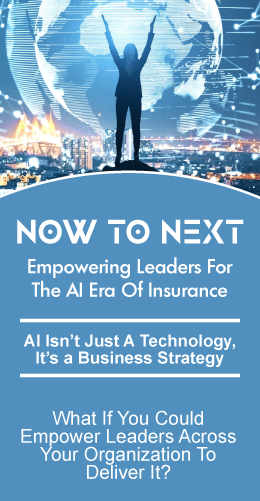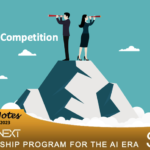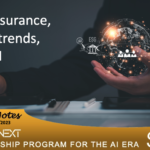
Personal and commercial customers of P&C insurance face a range of emerging risks over the next 10 years. The increasing use of technology and digitization means that cyber threats, such as data breaches and ransomware attacks, will become common. Climate change intensifies natural disasters like hurricanes, wildfires, floods, and other extreme weather events. The widespread adoption of autonomous technologies will introduce new risks and liabilities for personal and commercial customers. New data sources and Artificial Intelligence can help make those risks far more transparent and predictable and help prevent them. But not without concrete executive action.
Examples of emerging risks, data sources, and AI capabilities:
Political and regulatory risks: Changes in political and regulatory environments, such as trade wars and increased regulatory scrutiny, introduce new risks for businesses and individuals.
Pandemics and Health Risks: The COVID-19 pandemic has highlighted the potential impact of pandemics and other health risks on individuals and businesses. Changes in demographics, such as an aging population and increasing diversity, also introduce new risks and challenges for insurers and their customers.
Demographic Changes: New mobility models for different generations, as well as changes in workspaces and work models and an increasingly digital world, create new risks for insurers and their customers, particularly as they develop new products and distribution models that support the changing needs of these populations.
AI can gather and analyze data from various sources, including government websites, census data, social media profiles, news articles, and policy documents, to monitor political and regulatory changes and changing needs and preferences in real time. AI and Large language models can process vast amounts of text data to identify emerging political and regulatory trends. AI-driven sentiment analysis can gauge public and market sentiment, aiding decision-making in response to evolving political environments and changing needs and risks of different generations.
Emerging technologies, social inflation, and reputational risks are other potential challenges individuals and businesses face. Emerging technologies such as blockchain, artificial intelligence, and the Internet of Things could introduce new risks and opportunities for insurers and their customers. Social inflation, which refers to the increasing cost of settlements and judgments, results in higher insurance premiums for personal and commercial customers. The rise of social media and the 24-hour news cycle has also increased the risk of reputational damage for businesses and individuals.
Social media platforms, news articles, and customer reviews are rich sources of information on public perception and potential liability issues.
AI can monitor social media and news for mentions of insurance-related topics and assess sentiment. It can alert insurers to potential reputational risks in real time, allowing for swift crisis management. AI can also help in claims fraud detection, reducing the impact of social inflation on premiums.
Data privacy: As more data is generated and stored by connected devices, personal information and data can be vulnerable to hacking, theft, or misuse, leading to financial and reputational harm for individuals and businesses.
Data breach reports, cybersecurity blogs, and legal databases can provide insights into data privacy vulnerabilities.
AI can analyze cybersecurity trends and identify potential threats. It can assist in evaluating the security posture of insured entities and recommend improvements. Machine learning models can detect anomalies in data access patterns, helping prevent data breaches and privacy violations.
Environmental risks: With the move towards sustainable technologies and products, there are new risks associated with the production, use, and disposal of these products. These risks include concerns about battery safety and proper disposal, as well as the environmental impacts of manufacturing
and transportation.
Environmental monitoring data, sustainability reports, and data on the production, use, and disposal of environmentally sensitive products can provide insights into environmental risks.
AI can analyze environmental data to identify potential risks associated with sustainable technologies and products. Machine learning models can assess the environmental impacts of manufacturing, transportation, and product disposal. AI-driven risk assessments can help insurers offer coverage tailored to environmental vulnerabilities, such as battery safety concerns. Additionally, AI can assist in claims processing related to environmental damage, facilitating timely assistance to policyholders affected by environmental incidents.
Distracted driving: Widespread use of mobile devices, drivers may be tempted to text, make phone calls, or use social media while driving, taking their attention away from the road and increasing the risk of accidents.
Telematics data from connected vehicles, mobile device usage data, and accident reports can provide insights into distracted driving incidents.
AI-powered telematics systems can monitor driver behavior in real-time, identifying signs of distracted driving and suggest modifications to that behavior in real time. Machine learning algorithms can predict risky behaviors and alert drivers or insurers. AI-driven claims processing can expedite accident investigations and settlements.
Climate-related risks: Climate change leads to more frequent and severe weather events, which can damage homes and property. Homeowners may also face increased risk from wildfires, flooding, and other natural disasters.
Climate data from meteorological agencies, satellite imagery, and climate research institutions provide information on weather patterns and climate change impacts.
AI can analyze climate data to predict and mitigate risks associated with extreme weather events. Machine learning models can assess property vulnerabilities and recommend preventive measures. AI-driven claims processing can expedite assistance to affected policyholders during disasters.
Key Takeaways
Emerging Risks are Multifaceted: Emerging risks in the insurance industry encompass various challenges, from cybersecurity threats and climate change to regulatory shifts and reputational risks. Recognizing this diversity is crucial for effective risk management.
Data Is the Lifeblood: New data sources, including IoT devices and social media, are providing insurers with unprecedented access to information. Leveraging this data is key to understanding and mitigating emerging risks.
AI Enhances Risk Assessment: AI’s predictive capabilities empower insurers to assess risks in real time. This proactive approach is essential for staying ahead of emerging threats.
Personalization Is Expected: Digital natives and tech-savvy customers expect highly personalized insurance solutions. AI-driven personalization is now a standard in the industry.
Speed and Precision Matter: In the face of rapidly evolving risks, the speed and precision of risk assessment are paramount. AI enables insurers to respond swiftly and accurately.
Cybersecurity Is Non-Negotiable: With the rise in cyber threats, robust cybersecurity measures are no longer optional. Customers demand comprehensive protection against data breaches and cyberattacks.
Environmental Risks Are Growing: Climate-related risks are intensifying, leading to more frequent and severe natural disasters. Insurers must adapt to these changing patterns.
Social Media’s Impact: The 24/7 news cycle and the influence of social media magnify reputational risks. A single negative event can spread rapidly, making reputation management a top priority.
Talent and Collaboration: Developing AI capabilities requires a skilled workforce. Insurers must invest in talent development and collaborate with Insurtech companies to stay competitive.
Customer Education: Educating customers about the benefits of AI in insurance is vital. Building trust through transparency and clear communication is key to successful AI adoption.
Next Steps
Against this growing spectrum of emerging and increasingly complex risks and emerging capabilities, we need to move from discussion to action. We need to understand what our current status is to guide our strategic decisions and define concrete executive actions to drive the transformation needed. Here’s a starter set.
Critical Questions
What Are Our Current Efforts? How are we currently identifying, evaluating, and acting on emerging risks within our organization?
Data Sources and Evaluation: What data sources are we evaluating to understand emerging risks? Are we exploring new and innovative data sources?
System Compatibility: Will our existing systems and technologies be able to handle the data and analytics required to address emerging risks? Do we need to invest in new technology or upgrade existing ones?
AI Priorities: Have we identified our AI priorities in relation to emerging risks? Which areas or processes will benefit the most from AI implementation?
Overall Strategy: Do we have a comprehensive strategy for developing AI and data analytics capabilities to address emerging risks proactively?
Talent Development: What steps are we taking to train our existing workforce in AI and data analytics? Are we hiring new talent with the necessary expertise?
Regulatory Compliance: How do our AI and data analytics efforts align with regulatory requirements in the insurance industry? Are we prepared for potential regulatory changes related to emerging risks?
Collaboration: Are we collaborating with external partners, such as Insurtech companies or data providers, to enhance our capabilities in addressing emerging risks?
Risk Assessment Framework: Have we established a robust framework for assessing the severity and likelihood of emerging risks? How frequently do we update this framework?
Scenario Planning: Are we conducting scenario planning exercises to prepare for various emerging risk scenarios? How often do we revisit and adjust these scenarios?
Customer Communication: How do we communicate with our customers about the emerging risks they face and the measures we take to protect their interests?
Competitive Analysis: What are our competitors doing regarding AI and data analytics to address emerging risks? How do we compare, and where can we gain a competitive edge?
Testing and Validation: How do we test and validate the effectiveness of our AI models and data analytics in identifying and mitigating emerging risks?
Resource Allocation: Are we allocating sufficient resources, including budget and manpower, to our initiatives related to emerging risks and AI implementation?
Crisis Management: Do we have a well-defined crisis management plan for handling emerging risks that materialize into crises? How do AI and data analytics support this plan?
Measuring ROI: How do we measure the return on investment (ROI) of our AI and data analytics initiatives in managing emerging risks?
Continuous Improvement: What processes are in place to continuously improve our AI models, data analytics capabilities, and overall readiness for emerging risks?
Executive Actions
Establish an Emerging Risk – AI Task Force: Create a dedicated task force or committee for identifying, evaluating, and addressing emerging risks. Ensure representation from various departments, including data analytics, IT, risk management, and legal, to foster cross-functional collaboration.
Data Governance: Strengthen data governance practices, ensuring ethical data management and transparency.
Define Clear AI Priorities: Develop a clear roadmap for AI implementation by prioritizing specific areas where AI and data analytics can have the most significant impact on managing emerging risks.
Invest in Data Infrastructure: Allocate resources to enhance the organization’s data infrastructure, including data collection, storage, quality, and security. Ensure that data sources are diverse and relevant to emerging risks.
AI Talent Development: Invest in training and upskilling our existing workforce in AI and data analytics. Additionally, actively recruit AI talent to fill critical roles within your organization.
Summary:
Taking decisive actions to accelerate and support this work isn’t a “nice to have.” It’s a critically urgent requirement. Embracing AI and the expectations of digital natives is essential for remaining competitive and meeting the ever-evolving demands of our customers in the dynamic era.







